Vietnam, a land brimming with rich history, captivating culture, and breathtaking landscapes, is arguably most celebrated for its incredible cuisine. From bustling street corners to elegant restaurants, the world of Vietnamese food is a vibrant tapestry of exotic flavors, aromatic spices, and fresh ingredients waiting to be explored. As a traveler and a food enthusiast, I find that delving into Vietnamese specialty food is one of the most profound ways to connect with the country’s soul and understand its people.
This journey through Vietnam’s culinary heart reveals not just delicious meals, but also stories of tradition, adaptation, and regional identity. Each dish tells a tale, reflecting the local environment, historical influences, and daily life. Whether you’re a seasoned foodie or new to Southeast Asian flavors, the diverse array of Vietnamese specialty food offers an unforgettable sensory experience that goes far beyond mere sustenance, truly embodying the spirit of exploration and cultural immersion.
Pho: A Soulful Vietnamese Specialty Food
Often considered the national dish, pho is a comforting noodle soup that has garnered international fame as a quintessential Vietnamese specialty food. Simple yet profound, it’s a dish where the beauty lies in the clarity and depth of the broth, a testament to the careful art of slow simmering. Traditionally enjoyed as a breakfast staple by workers in the northern rice fields, pho has evolved into a beloved meal consumed at any time of the day across Vietnam and the globe.
The base of pho is a fragrant broth, typically made from beef bones (pho bo) or chicken (pho ga), infused with warming spices like star anise, cinnamon, cloves, and ginger. This is poured over delicate rice noodles and tender slices of meat, then finished with a scattering of fresh herbs like green onion and cilantro. The magic often happens at the table, where diners can customize their bowl with lime, chili, bean sprouts, and various herbs, creating a personalized flavor symphony.
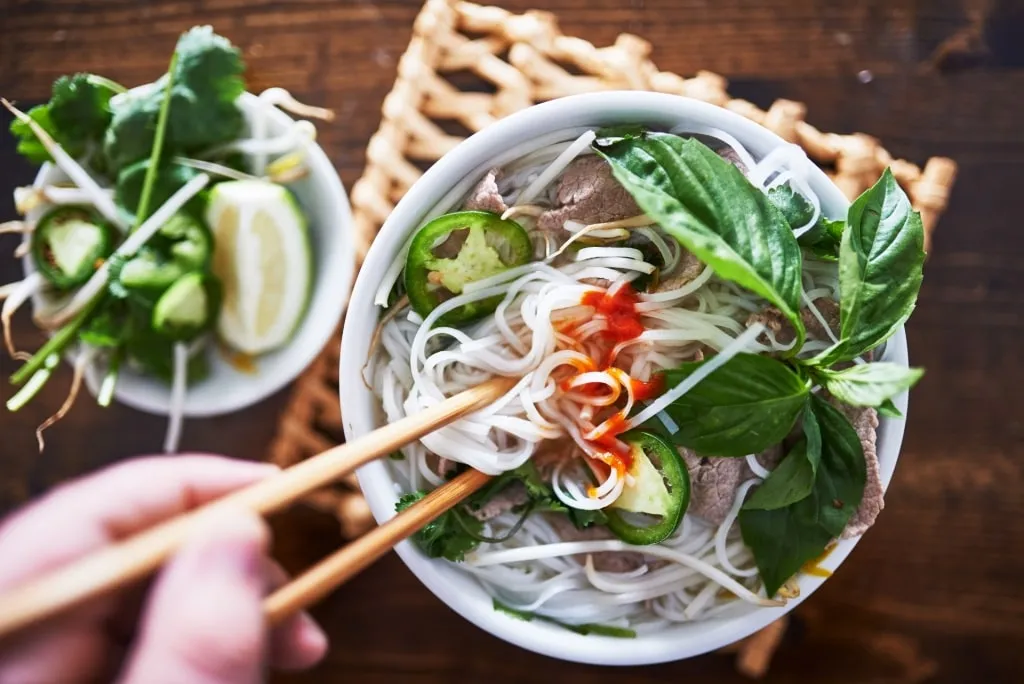 Person eating pho
Person eating pho
Experiencing pho in Vietnam allows you to appreciate its regional nuances. While the northern version (pho Bac) tends to be simpler and broth-focused, the southern style (pho Nam) found in places like Ho Chi Minh City often features a slightly sweeter broth and a wider array of accompanying herbs and garnishes. Finding a perfect bowl is easy; it’s available everywhere from humble street stalls, where the aroma of simmering broth fills the air, to more formal restaurants.
Banh Mi: The Iconic Vietnamese Specialty Sandwich
A delicious legacy of Vietnam’s colonial past, banh mi is a unique fusion sandwich that has become a global symbol of Vietnamese specialty food. Using the French baguette as its base, the banh mi transforms this European bread into something uniquely Vietnamese by filling it with a vibrant mix of local ingredients. Originating in Saigon (now Ho Chi Minh City), it perfectly encapsulates the country’s ability to adapt and innovate.
The baguette itself is lighter and crispier than its French counterpart, providing the perfect crunch. Inside, a typical banh mi features a variety of fillings, often including different types of pork (like roasted pork belly, Vietnamese ham, or pork pâté), layered with pickled daikon and carrots (do chua), cucumber slices, cilantro, and often seasoned with mayonnaise, chili sauce, and soy sauce. The combination is a delightful explosion of textures and flavors – savory, tangy, fresh, and spicy.
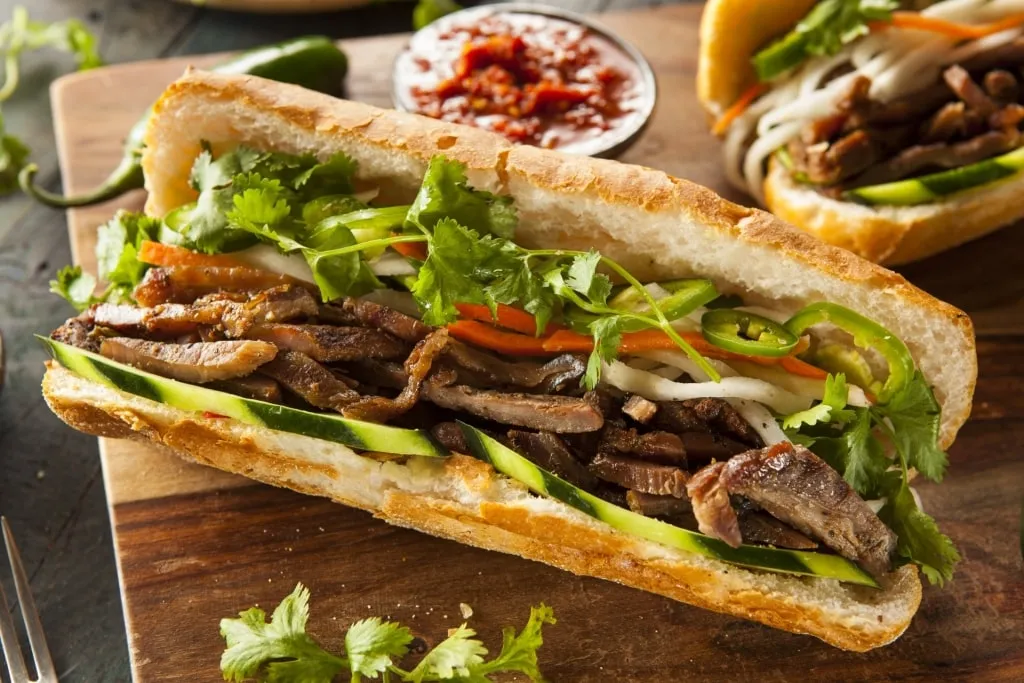 Banh Mi, best food in Vietnam
Banh Mi, best food in Vietnam
Planning Your travel to las vegas nevada
Plan Your Perfect Mackinac Island Vacation – Your Essential Guide
Exploring Cities In Las Vegas – Uncovering Nearby Wonders 2025
Banh mi is incredibly versatile, with endless variations found across the country, from simple fillings like fried egg (banh mi trung) to more complex combinations. It’s the ultimate street food – portable, affordable, and utterly satisfying – making it a perfect snack or quick meal any time of the day or night. Trying banh mi from different vendors is a mini-culinary adventure in itself, revealing subtle differences in bread, fillings, and seasoning that reflect local tastes.
Goi Cuon: Fresh & Healthy Vietnamese Specialty Food
Known globally as Vietnamese summer rolls or fresh spring rolls, goi cuon stands out as a refreshing and healthy Vietnamese specialty food. Unlike fried spring rolls, these are not cooked, showcasing the crispness and natural flavors of their fresh ingredients. They are a popular appetizer or light snack, perfect for Vietnam’s warm climate, offering satisfaction without being overly heavy.
Goi cuon are made by wrapping a mix of fresh vegetables (like lettuce, herbs), cooked shrimp, slices of pork, and rice vermicelli noodles in delicate, translucent rice paper. The assembly requires a bit of finesse, creating neat, tight rolls that allow the vibrant colors of the fillings to peek through. The fresh herbs, particularly mint and Thai basil, lend a wonderful aromatic lift to each bite.
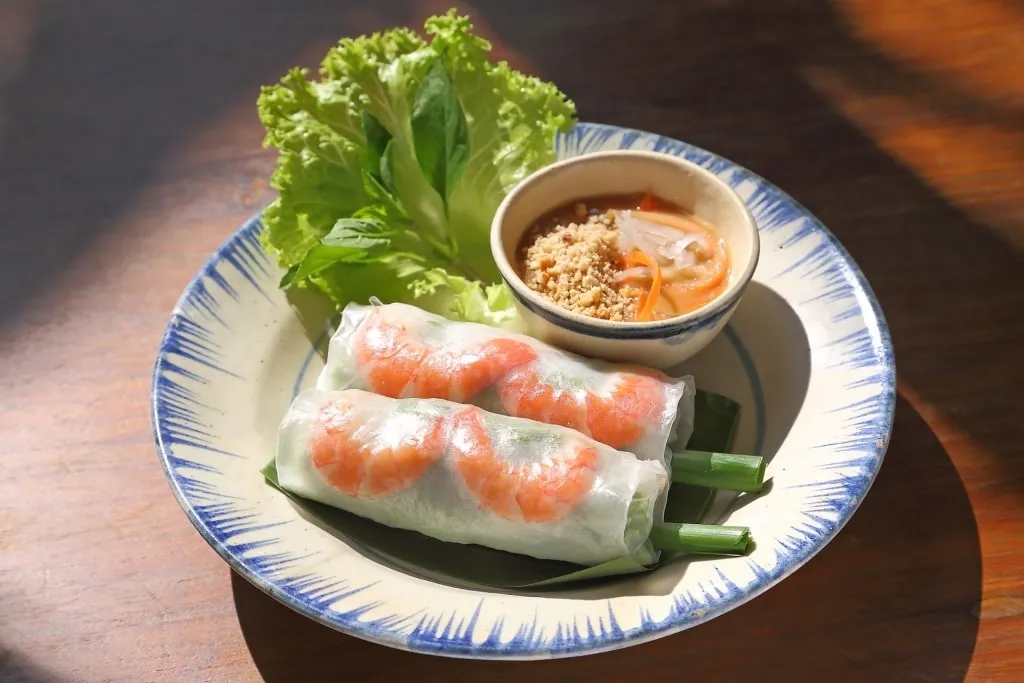 Plate of Goi cuon
Plate of Goi cuon
The accompanying dipping sauce is crucial to the goi cuon experience. While a classic nuoc cham (fish sauce-based dipping sauce) is common, many places serve them with a rich peanut sauce (tuong den) or a pungent fermented fish sauce (mam nem), particularly in the South. Dipping the cool, crisp roll into the flavorful sauce creates a perfect balance. You can find excellent goi cuon at restaurants and markets throughout Vietnam, often made fresh to order.
Banh Xeo: Sizzling Vietnamese Specialty Crepes
Banh xeo, affectionately nicknamed the “sizzling cake,” is a delightfully crispy and savory Vietnamese specialty food pancake or crepe. Its name originates from the loud sizzling sound the rice flour batter makes when it hits the hot oil in the pan. This golden, turmeric-colored crepe is typically folded in half and stuffed with a delicious filling of shrimp, pork, sliced onions, and bean sprouts.
The batter for banh xeo is primarily made from rice flour, coconut milk or cream, water, and a touch of turmeric for that characteristic yellow hue. Although it resembles an omelet in shape, it contains no egg (though sometimes egg is added). The goal is a thin, crispy edge with a slightly softer center.
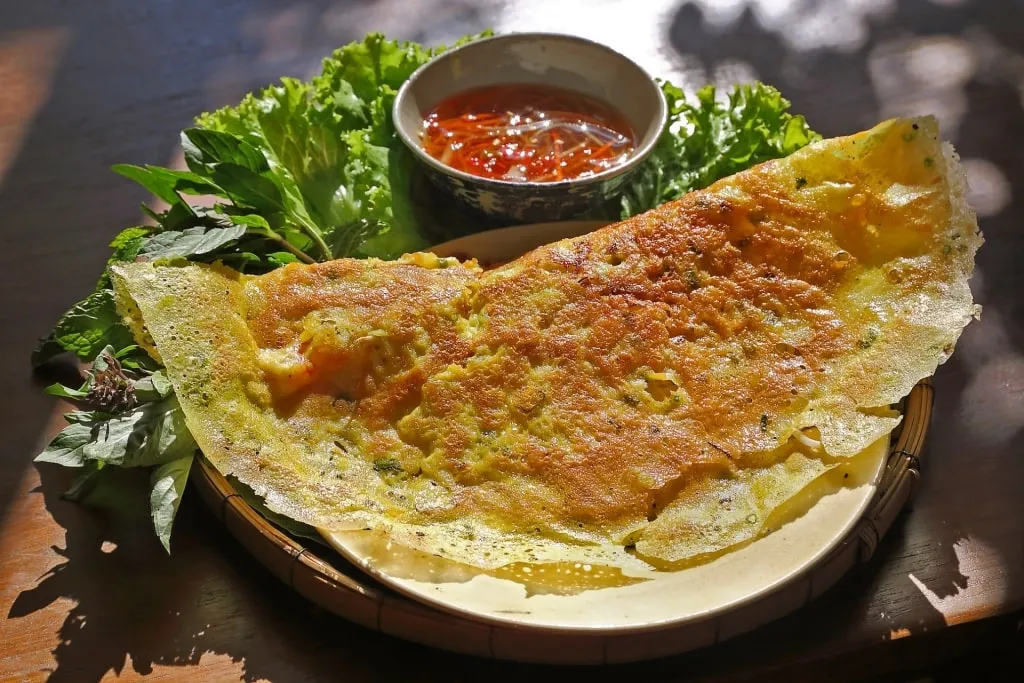 Plate of Banh xeo
Plate of Banh xeo
Eating banh xeo is an interactive and messy joy. Large crepes are often cut into smaller portions. You take a piece, wrap it in a large lettuce leaf along with various fresh herbs like mint, basil, and cilantro, and then dip the whole bundle into nuoc cham. The contrast between the hot, crispy pancake, the cool, fresh greens, and the tangy dipping sauce is simply sublime, making banh xeo a must-try Vietnamese specialty food.
Mi Quang: Central Vietnam’s Noodle Specialty Food
Hailing from the central region of Vietnam, particularly Quang Nam province (which includes Hoi An and Da Nang), mi quang is a unique and flavorful noodle dish that stands proudly alongside pho as a significant Vietnamese specialty food. Unlike pho, which is served in a generous amount of broth, mi quang features just a small quantity of rich, flavorful broth that barely coats the noodles. This minimal broth style gives it a distinct character.
The noodles themselves are typically wide, flat yellow rice noodles. The broth is complex, often made from pork and chicken bones, seasoned with fish sauce, black pepper, shallots, and turmeric, which gives the broth a lovely golden color. Common protein toppings include shrimp, pork slices, chicken, or fish. What truly sets mi quang apart is the array of garnishes and textures: toasted peanuts, sesame rice crackers (banh trang me), fresh herbs (like basil, mint, coriander), sliced banana blossom, and often a hard-boiled quail egg or a dollop of chili paste.
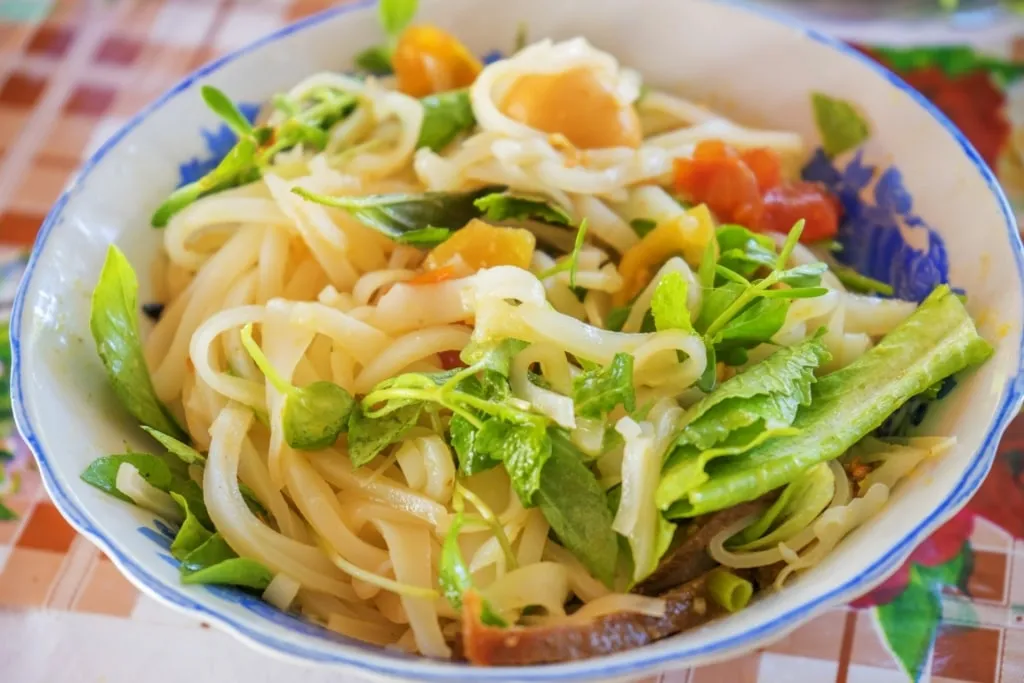 Bowl of mi quang
Bowl of mi quang
Eating mi quang feels like experiencing a blend of soup and salad. The limited broth concentrates the flavors, and the mix-ins provide layers of texture and taste. Variations abound, including versions with frog legs (mi quang ech) or snakehead fish. While originating in the center, you can now find mi quang in many cities, but experiencing it in its homeland of Quang Nam offers the most authentic taste of this cherished Vietnamese specialty food.
Cha Ca: A Historic Hanoi Vietnamese Specialty Food
Cha ca is more than just a dish; it’s a culinary institution, particularly in Hanoi, where a street is famously named after it (Cha Ca street). This flavorful grilled fish dish holds a special place in the heart of northern Vietnamese specialty food, boasting a history that dates back over a century. It was reputedly created by the Doan family in Hanoi and served to troops during French colonial rule.
The star of the dish is fish, typically a firm white fish like snakehead or catfish, which is marinated in a vibrant mixture of turmeric, galangal, ginger, garlic, shrimp paste, and dill. The marinated fish is then grilled or pan-fried until golden. What makes cha ca a unique experience is that it’s often served tableside in a hot pan, nestled among a generous amount of fresh dill and green onions, sizzling invitingly.
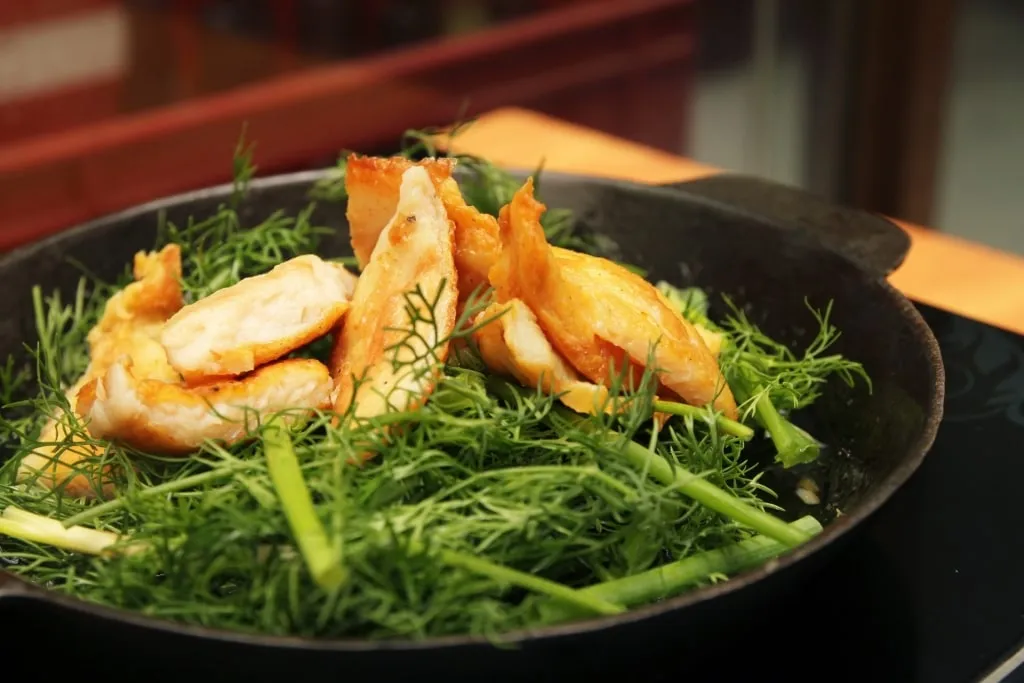 Cha ca in a skillet pan
Cha ca in a skillet pan
Cha ca is served with vermicelli noodles, roasted peanuts, and a variety of fresh herbs like basil and mint. The magic happens when you assemble your bite: a piece of fish, some noodles, herbs, peanuts, all dipped into a small bowl of mam nem (fermented shrimp paste sauce) mixed with chili and lime. It’s a symphony of textures and intense, aromatic flavors – spicy, savory, herbaceous, and slightly tangy. Cha ca is usually found in dedicated restaurants rather than street stalls, offering a focused experience on this single, celebrated Vietnamese specialty food.
Cao Lau: Hoi An’s Unique Vietnamese Specialty Food
Originating exclusively from the ancient town of Hoi An in Central Vietnam, cao lau is a unique and slightly mysterious noodle dish that is considered a signature Vietnamese specialty food of the region. Its distinctiveness is often attributed to its key ingredients, particularly the noodles and the water used to make them. Local lore suggests the water must come from the ancient Ba Le well in Hoi An, and the noodles are made with ash from specific trees mixed into the dough. While the mystical elements are debated, the resulting dish is undeniably special.
Cao lau noodles are thick, chewy, and have a unique, slightly smoky flavor and greyish color. The dish features slices of char siu pork (Vietnamese barbecued pork), fresh herbs (mint, basil, cilantro, Vietnamese fish leaf), bean sprouts, and crispy croutons or pork cracklings. It’s typically served without a lot of broth, just a small amount of a rich, savory sauce at the bottom of the bowl, allowing the texture of the noodles and the flavors of the toppings to shine.
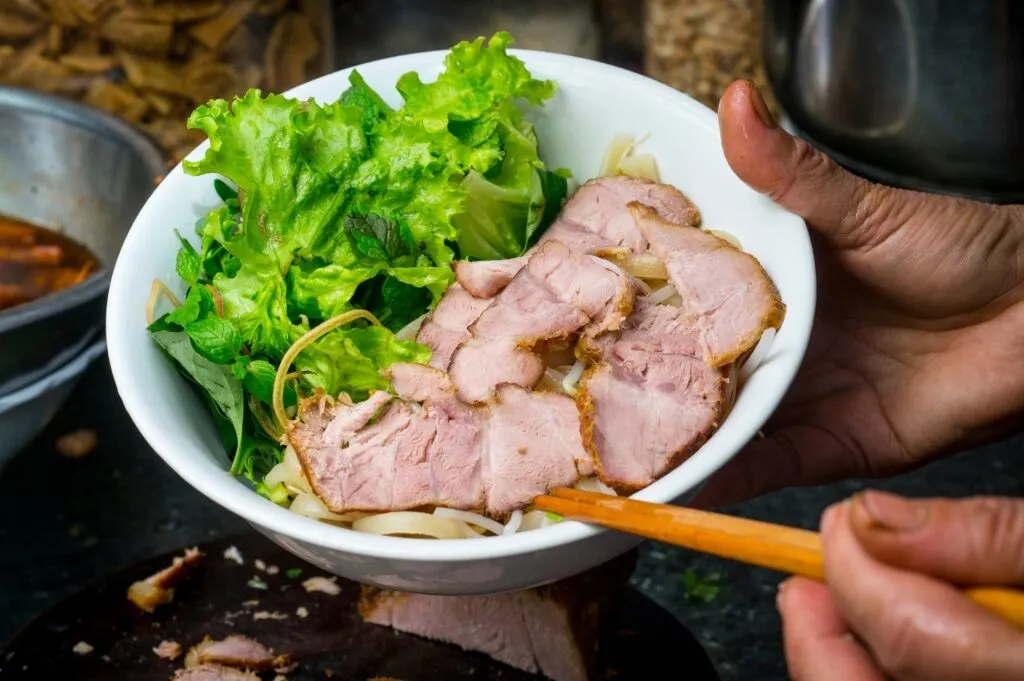 Bowl of cao lau topped with char siu
Bowl of cao lau topped with char siu
The char siu pork is marinated and slow-cooked, giving it a tender texture and a sweet-savory glaze. When you mix everything together, the noodles absorb the sauce, creating a harmonious blend of flavors and textures – chewy noodles, tender pork, crisp greens, crunchy croutons, and the rich sauce. Trying cao lau in Hoi An is considered essential to experiencing authentic Vietnamese specialty food in this charming town. It’s available in restaurants and some market stalls.
Bo Kho: Comforting Vietnamese Specialty Beef Stew
For those seeking warmth and depth of flavor, bo kho is a hearty and aromatic Vietnamese specialty food that serves as the ultimate comfort dish. This slow-cooked beef stew is rich, fragrant, and deeply satisfying, embodying the nurturing aspect of Vietnamese home cooking. It’s a dish that brings together tender pieces of beef and vegetables in a complexly spiced broth.
The stew is made by simmering cubes of beef (often brisket or shank) with carrots and sometimes potatoes or daikon radish in a broth flavored with a blend of Asian spices including lemongrass, star anise, cinnamon, cloves, and five-spice powder, along with garlic, shallots, and tomato paste for richness and color. The long, slow cooking process ensures the beef becomes incredibly tender and the flavors meld beautifully, creating a thick, fragrant sauce.
A generous bowl of Bo Kho, a deeply comforting Vietnamese specialty food beef stew.
Bo kho is typically served in a bowl and can be enjoyed in several ways: over rice, with rice noodles, or, perhaps most famously, with a crusty Vietnamese baguette for dipping into the rich sauce. Fresh herbs like cilantro, basil, and sometimes saw-tooth coriander are often added just before serving to brighten the flavors. It’s a popular dish for breakfast or lunch and is commonly found on restaurant menus, especially in the southern parts of Vietnam like Ho Chi Minh City.
Ca Kho To: Caramelized Vietnamese Specialty Fish
A staple in many Vietnamese households, ca kho to is a classic caramelized fish dish served in a traditional clay pot. This savory and slightly sweet Vietnamese specialty food showcases a common preparation method in Vietnamese cuisine, particularly in the Mekong Delta region where fish is abundant. It’s a comforting, rustic dish typically eaten with plain white rice.
The dish usually features firm white fish, such as snakehead fish or catfish, cut into steaks or chunks. The fish is braised slowly in a rich caramel sauce called nuoc mau, which is made by caramelizing sugar in oil to a deep amber color before adding fish sauce, soy sauce, coconut juice (for sweetness and tenderizing), shallots, garlic, black pepper, and sometimes chili. Cooking it in a clay pot helps to distribute heat evenly and retain moisture, resulting in incredibly tender fish and a thick, glossy sauce.
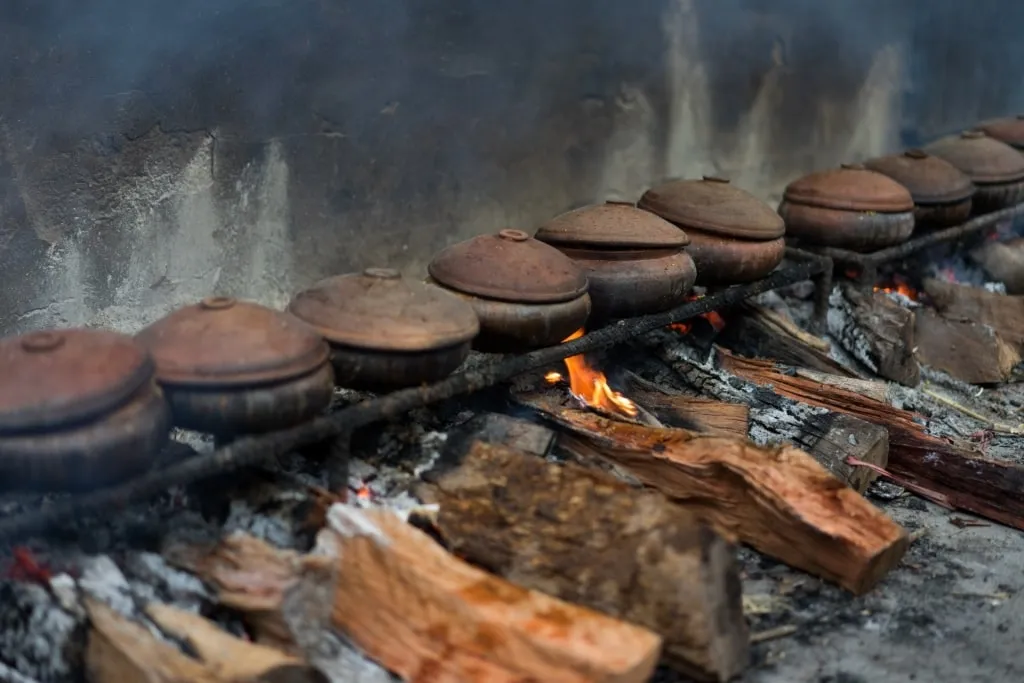 Pots of Ca kho to
Pots of Ca kho to
Ca kho to is the kind of dish that defines Vietnamese home cooking – simple ingredients transformed into something deeply flavorful. The sauce is a perfect balance of sweet, salty, and savory, clinging beautifully to the fish. It’s usually garnished with fresh green onions before serving. While often a home-cooked meal, you can find excellent versions of ca kho to in restaurants across Vietnam, recognized by the signature clay pot it’s served in.
Bun Cha: Hanoi’s Beloved Vietnamese Specialty Lunch
Bun cha is arguably the most famous Vietnamese specialty food from Hanoi after pho, and it holds a special place as the city’s quintessential lunchtime meal. It’s a vibrant and interactive dish centered around grilled pork and noodles, offering a wonderful contrast of flavors and textures that embodies the lively spirit of Hanoi’s street food scene.
The dish consists of several components served separately. The main attraction is the grilled pork, which comes in two forms: seasoned, grilled pork patties (cha) and thin slices of grilled pork belly (nem). These succulent pieces of pork are served in a warm, diluted dipping sauce (nuoc cham) made from fish sauce, sugar, vinegar, lime juice, and sliced green papaya or carrots. Alongside the pork and sauce are bowls of white rice vermicelli noodles (bun) and a generous platter of fresh herbs and leafy greens (like lettuce, perilla leaves, coriander, mint, and Thai basil).
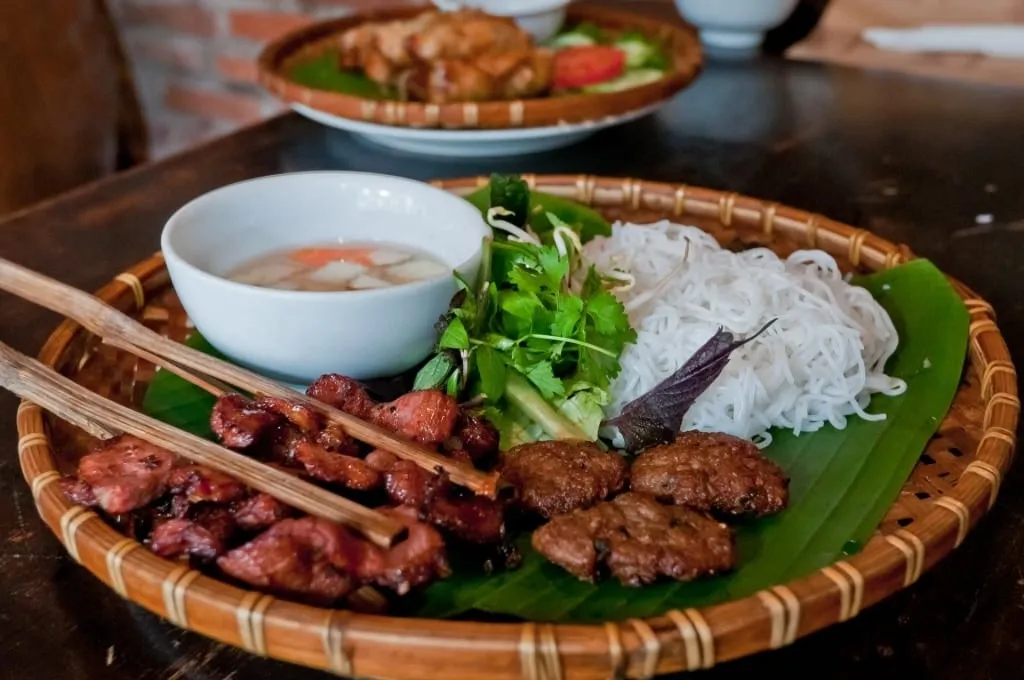 Bun cha, one of the best food in Vietnam
Bun cha, one of the best food in Vietnam
To eat bun cha, you typically take some noodles and herbs, dunk them into the dipping sauce with the grilled pork, and enjoy the combination in one mouthful. The smoky flavor of the grilled meat, the freshness of the herbs, the soft noodles, and the tangy, savory dipping sauce create a perfect harmony. Experiencing bun cha at a bustling street stall in Hanoi, surrounded by the sights and sounds of the city, is a truly immersive way to enjoy this iconic Vietnamese specialty food.
Rau Muong Xao Toi: A Simple & Flavorful Vietnamese Specialty Side
Often overlooked in favor of more elaborate dishes, rau muong xao toi (stir-fried water spinach with garlic) is a ubiquitous and much-loved Vietnamese specialty food that serves as a perfect accompaniment to many meals. Simple yet incredibly flavorful, it highlights the importance of fresh vegetables in Vietnamese cuisine and the power of humble ingredients treated well.
Water spinach, also known as morning glory, is a leafy green vegetable with hollow stems that is native to Southeast Asia. For this dish, the tender shoots and leaves are typically blanched briefly in hot water before being stir-fried quickly in a hot wok with a generous amount of minced garlic. Seasoning usually includes fish sauce, a pinch of sugar, and sometimes a touch of oyster sauce, enhancing the natural green flavor without overpowering it.
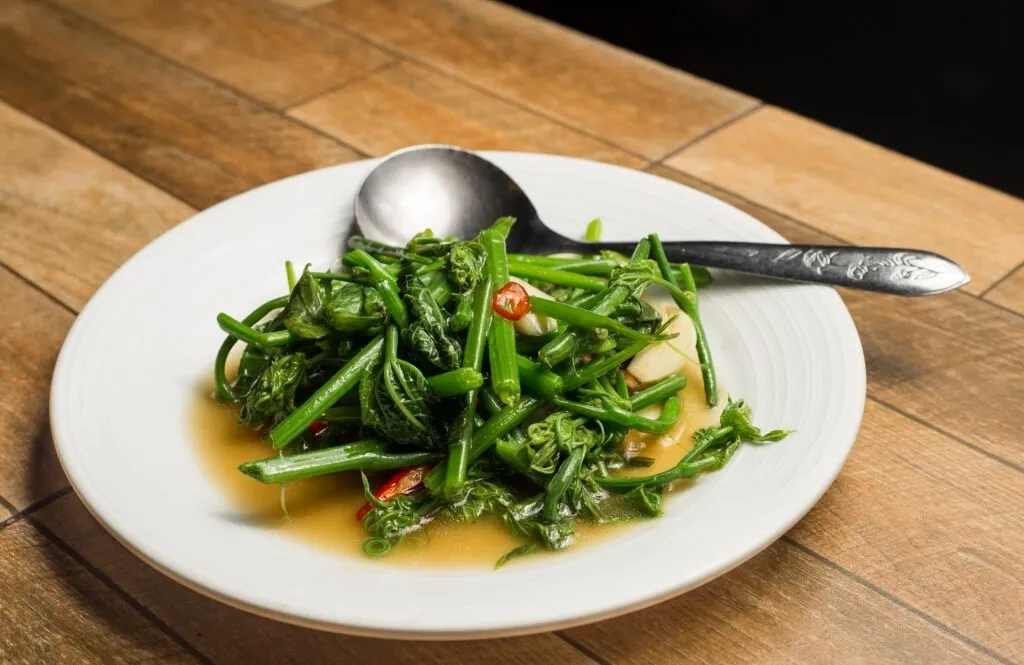 Plate of Rau muong xao toi
Plate of Rau muong xao toi
Rau muong xao toi is popular with everyone, including vegetarians, but is also frequently paired with meat dishes like grilled pork or fish. Its slightly crisp texture and savory, garlicky flavor make it a refreshing counterpoint to richer main courses. Served hot, often alongside steamed white rice, it’s a fundamental part of a traditional Vietnamese meal composition, demonstrating how even simple vegetable preparations can be a significant Vietnamese specialty food.
Banh Bao Vac: Hoi An’s ‘White Rose’ Vietnamese Specialty Dumplings
Another culinary gem specific to the charming town of Hoi An are banh bao vac, often referred to as “white rose dumplings.” Named for their delicate appearance said to resemble white roses when plated, these steamed dumplings are a regional Vietnamese specialty food with a storied history tied to one family in Hoi An who traditionally held the secret recipe.
The dish actually consists of two types of dumplings served together. The banh vac is typically filled with a mixture of finely minced shrimp or pork, mushrooms, and seasoned with ingredients like lemongrass and garlic. The banh bao (not to be confused with the larger steamed buns found elsewhere) in this context is a smaller, more delicate dumpling, often filled with seasoned pork and wood ear mushrooms. Both share the same translucent, slightly chewy wrapper made from rice flour.
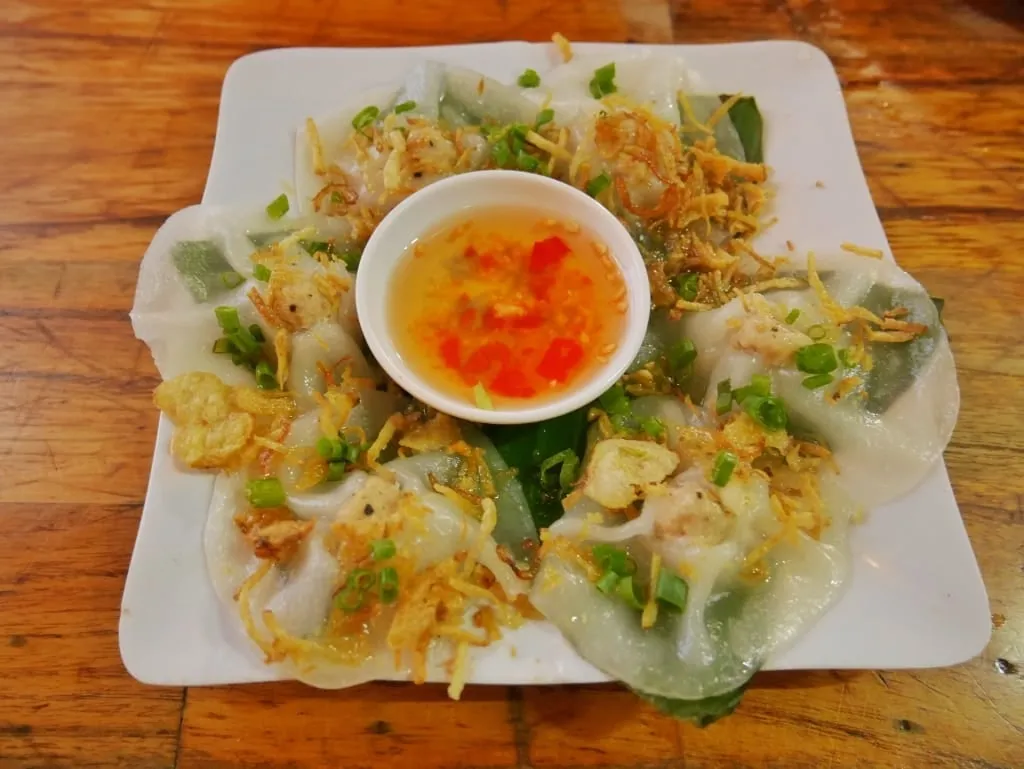 Banh bao vac plated as a flower
Banh bao vac plated as a flower
The dumplings are steamed until the wrappers become translucent and the fillings are cooked through. They are then arranged elegantly on a plate and typically garnished with crispy fried shallots. A light dipping sauce, often a sweet and sour mix of fish sauce, chili, and lime, is served alongside. The combination of the soft, chewy dumplings, the flavorful filling, the crunchy shallots, and the tangy sauce creates a delightful sensory experience, cementing banh bao vac’s status as a must-try Vietnamese specialty food in Hoi An.
Che Ba Mau: Vibrant Vietnamese Specialty Dessert
After exploring the savory depths of Vietnamese specialty food, it’s time to indulge in something sweet. Che ba mau, meaning “three color dessert,” is one of Vietnam’s most popular and visually appealing sweet treats. It’s a layered dessert drink or parfait that is particularly refreshing in the tropical heat, offering a delightful mix of textures and flavors.
Served in a tall glass, che ba mau is characterized by its distinct, vibrant layers, typically consisting of yellow mung bean paste, red beans (often kidney or adzuki beans), and green pandan-flavored jelly or noodles. These colorful components are then topped generously with creamy coconut milk or cream and a mound of crushed ice.
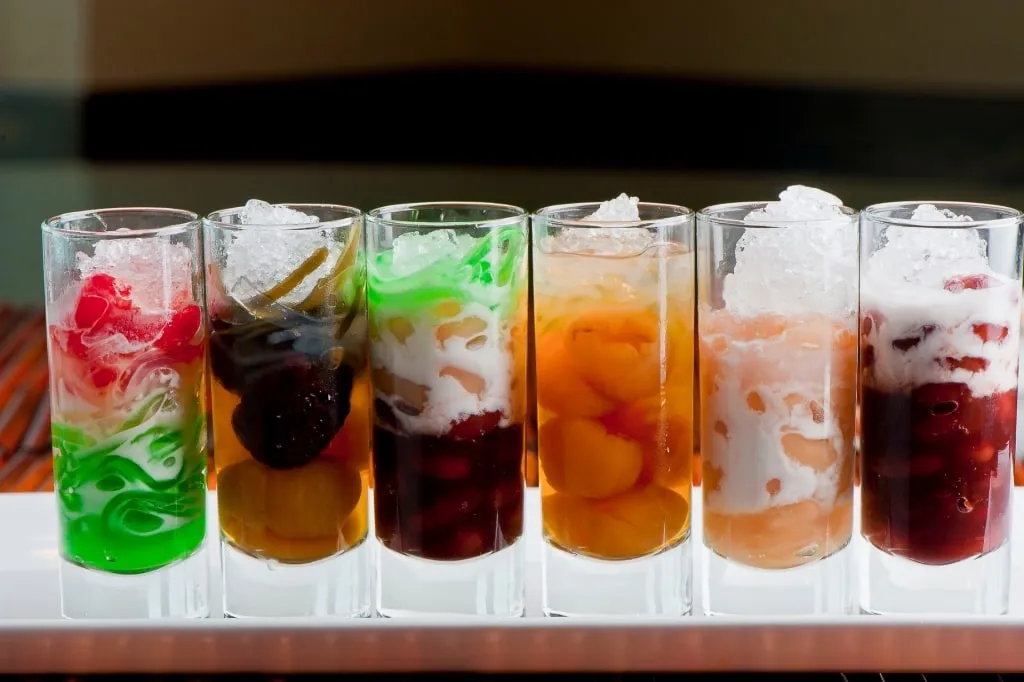 Glasses of Che ba mau
Glasses of Che ba mau
Before enjoying, it’s customary to mix all the layers together with a long spoon, transforming the layered parfait into a delightful, slushy mix. The result is a refreshing dessert that is simultaneously sweet, creamy, and offers a variety of textures – soft beans, chewy jelly, smooth paste, and crunchy ice. Che ba mau is widely available at street food stalls and markets throughout Vietnam, providing a sweet and cooling end to a culinary adventure through Vietnamese specialty food.
Bot Chien: Crispy Vietnamese Specialty Street Snack
Bot chien is a beloved Vietnamese specialty food, particularly popular as a street food snack, especially in the southern cities like Ho Chi Minh City. It’s essentially a savory fried rice flour cake, crispy on the outside and soft on the inside, often enjoyed as a late-night bite or a quick, satisfying treat any time of day.
The dish is made from cubes of rice flour dough that are steamed until firm, then cut into smaller pieces. These pieces are pan-fried in a hot wok with oil until they develop a wonderfully crispy exterior. An egg is often cracked directly into the wok and mixed with the frying dough pieces, creating a slightly scrambled, eggy coating that binds everything together.
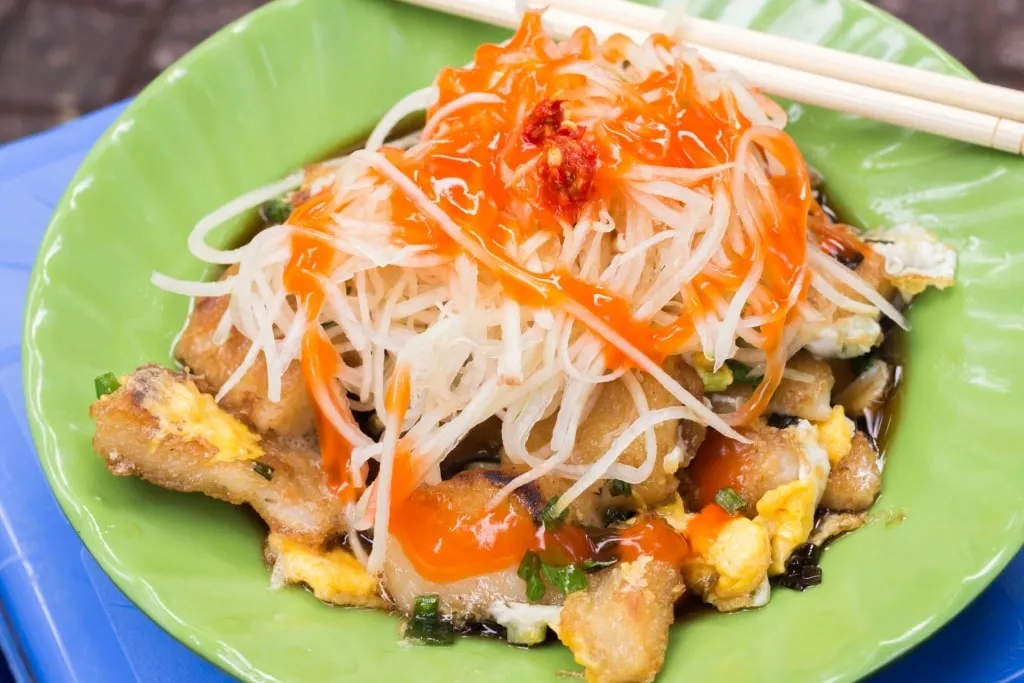 Bot chien, one of the best food in Vietnam
Bot chien, one of the best food in Vietnam
Bot chien is typically served hot, straight from the wok, garnished with chopped green onions and sometimes pickled radish or sweet papaya slices. The accompanying dipping sauce is usually a mix of rice vinegar, soy sauce, and chili sauce, offering a balance of sweet, sour, and spicy notes that perfectly complements the rich, crispy cake. The combination of textures – the crispy fried dough, the soft interior, the eggy bits, and the tangy sauce – makes bot chien a highly addictive and quintessential Vietnamese specialty food street experience.
Frequently Asked Questions About Vietnamese Specialty Food
Exploring Vietnamese cuisine often leads to questions from curious travelers. Here are a few common inquiries about Vietnamese specialty food:
Is Vietnamese food spicy?
Vietnamese food uses chilies extensively, but many dishes are not inherently spicy. Spice often comes from added chili sauce, fresh chilies, or chili paste that diners can add to their preference. Many core broths and bases, like pho, are aromatic rather than spicy, allowing you to control the heat.
Is Vietnamese street food safe to eat?
Generally, yes, but it’s wise to be cautious. Look for stalls that are busy, as high turnover means ingredients are fresh. Observe hygiene practices (though they may differ from what you’re used to). Eat where locals eat! Boiling hot dishes like pho or banh xeo cooked fresh in front of you are often safer bets. Trust your instincts.
What is the best city in Vietnam for foodies?
This is highly debated! Hanoi is famed for its traditional northern dishes like pho and bun cha. Ho Chi Minh City boasts incredible diversity, reflecting influences from across the country and its history, with a vibrant street food scene. Hoi An offers unique regional specialties like cao lau and white rose dumplings. Hue is known for its refined imperial cuisine. Each city offers a distinct culinary landscape of Vietnamese specialty food.
How do you eat Vietnamese food?
Many dishes are eaten with chopsticks and a spoon (for broth). Dishes like bun cha or banh xeo involve wrapping ingredients in lettuce and herbs before dipping. It’s common to share dishes in a group meal. Don’t be afraid to ask locals or your server for guidance on how to best enjoy a dish!
Conclusion
Embarking on a culinary journey through Vietnam is an adventure for the senses and a deep dive into the country’s rich cultural tapestry. From the comforting warmth of a bowl of pho to the vibrant explosion of a banh mi, each Vietnamese specialty food offers a window into the history, traditions, and daily life of its people. The connection between food, place, and identity is palpable in Vietnam, making every meal a meaningful experience.
Discovering Vietnamese specialty food is about more than just tasting delicious dishes; it’s about understanding the stories they carry, the communities they nourish, and the heritage they preserve. So, step off the beaten path, engage with local vendors, and let the flavors of Vietnam guide you. Your exploration of Vietnamese specialty food promises not just incredible meals, but unforgettable memories and a deeper appreciation for this remarkable country.
